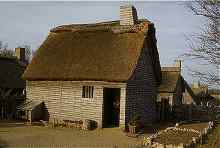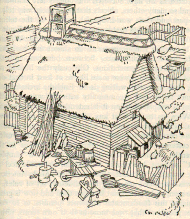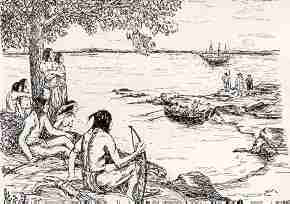1619
Joseph Northrup one of the founders of Milford born 1619 Wilkersfeld,
Yorkshire, England, or OR b. 1617 in Bradford,West
Riding, Yorkshire, England FROM ROOTSWEB.COM immigrated (possibly from Bradford, Yorkshire
Co. England) to America, July 26, 1637 aboard the "Hector and Martin";
one of "Eaton and Davenport" Co. ships.
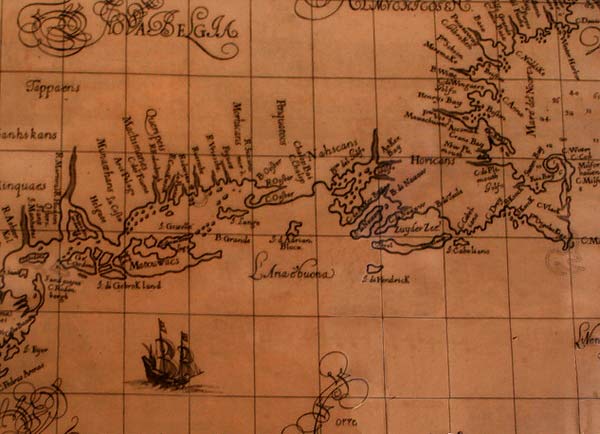
This map of Southern New England is identified as 1646. Long Island is just above the ship. Cape Cod on the far right has the distinctive curl.
http://www.ctheritage.org/encyclopedia/ctto1763/overviewctto1763.htm
They came from England in the ship "Hector and Martha," landing at Boston, July 26, 1637. The
emigrants of that period were, in great part, men of the professional
and middle classes, some of them of large landed estate.
The bulk, however, were God-fearing farmers from Lincolnshire
and Eastern counties. Eaton and Davenport's company
were mostly from Yorkshire, Hertfordshire and Kent. It
cannot now be determined from which county Joseph came —
perhaps from Yorkshire; and if of Sir Richard Saltonstall's
company, as it sometimes has been asserted, this is highly probable.
Sir Richard Saltonstall's company had spent some time at
Wethersfield, Conn., having come there from Watertown, Mass.,
but later came to New Haven. The Eaton and Davenport company,
meanwhile, had sailed down the coast from Boston, in
search of a good harbor, until they came to New Haven, where
they found the object of their search, and remained at New
Haven about a year.
In 1689, members from both companies formed the settlement
of Milford, Conn. The Hertfordshire and Yorkshire emigrants
seem to have tended to Milford, while others went to
Guilford."
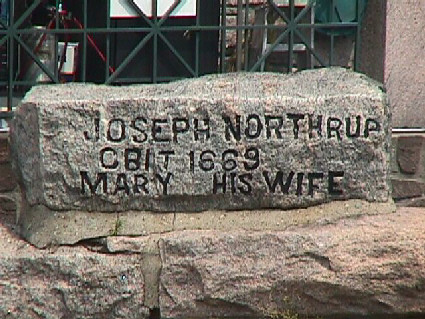
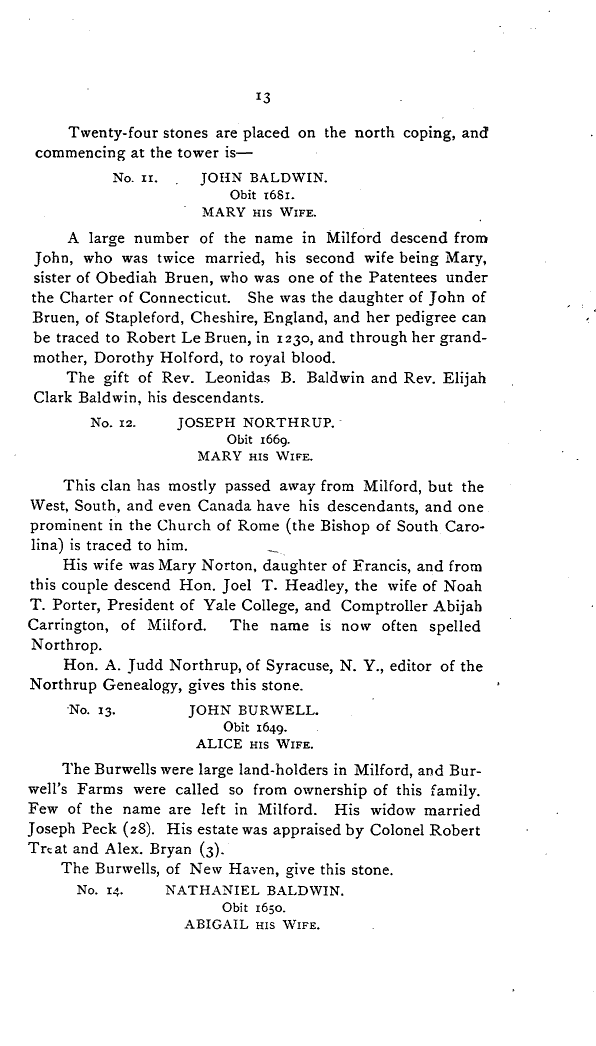
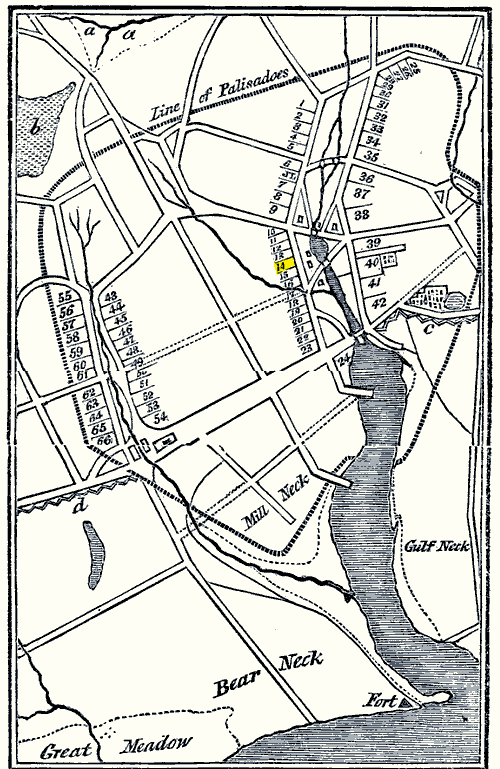
"The following persons are recorded immediately after, but not as free
planters, they not being in church fellowship, which was a requisite
qualification in the view of these colonists, before a person could be admitted
a "free planter."
Robert Plum
Roger Terrill
Joseph Northrup *A later map indicates Lot # 14 (yellow) was purchased by Joseph Northrup from Francis Bolts. This is now the location of the old Milford High School Building.
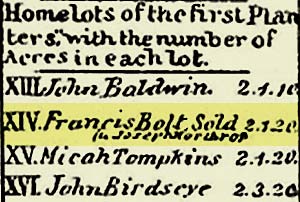
John Baldwin
William Slough
Andrew Benton
William Brooke
Robert Trent
Henry Lyon
John Powler
By this list it appears there were 54 heads of families, (admitting
them all married,) and if we allow only four individuals to a family, it
would make upwards of 200 persons who first came to Milford. From
some data on the Record, there is reason to suppose this calculation not
too large."
"The body of planters moved from New Haven to Milford by land,
following the devious Indian foot path, driving their cattle and other
domestic animals before them, while their household utensils and the
materials for " the common house" (which was fitted at New Haven)
were taken round by water. Thomas Tibbals piloted the company
through the woods to the place, " he having been there a number of
times before ;" for which service the town in 1670, "made him two
grants of land lying in Westfield as a free gift." All safely arrived;
they erected their common house at the head of the harbor on the west
side, and a few rude huts for temporary residences. They then proceeded
to form their civil polity.
Considering themselves as without
the pale of jurisdiction, (as in fact they were until they united with
New Haven in 1644,) they combined into a little republic. At their
first general meeting, Nov. 20th, 1639, it was voted " that the power of electing officers and persons to divide the land into lots, to take order
for the timber, and to manage the common interests of the plantation,
should be in the church only. It was also voted that they would guide
themselves in all their doings by the rule of the written Word of God,
till such time as a body of laws should be established." The 6rst settlers located themselves on each side of the Mill river
and the West End brook, probably for the convenience of water for
themselves and cattle. Most of them soon erected frame houses, COVT
ered with rent oak clapboards, in the old leanto style. Their house
lots were laid out in parallel narrow slips, containing each about three
acres. They thus kept near together for their better security in case of
an attack from the Indians. They immediately fenced in common
three tracts of land, in which each individual received by lot his portion
of " upland." Westfield, which was the land that lies south of the
town between the turnpike and great meadow was laid out to those
who settled at the west end. Eastfield, which enclosed the Gulf Neck,
was possessed by those located on the river. Mill Neck, the tract lying
between Wharf street and Bear Neck lane, was owned by a part of
both. Each person was further allotted a piece of meadow land lying
either in the great or the harbor meadows. As the population increased
and the danger from the Indians became less, the land further from
the center was gradually laid out and settled. At the second General Court, held March 9th, 1640, " It was agreed
between William Fowler and the brethren that he should build a mill
and have her going by the last of September." For his encouragement
the town made him a grant of 30 acres of land, which long bore
the name of the mill lot. This agreement had reference only to a grist
mill, but he soon added a saw mill. This mill establishment is yet retained
in the family. At the next General Court held November 24th,
1640, " With common consent and general vote of the freemen, the
plantation was named Milford," in commemoration of the town of this
name in their native England. The Court of Jive Judges at this meet-
ma were directed " to build a bridge over the Mill river with all expedition,"
and also "to set out a meeting house thirty feet square, after
such manner as they should judge the most convenient for the public good." The site of the building was the same of the present meeting
house of the first society. In 1709, this house had become so much
crowded that it was voted in town meeting that " whosoever should
needlessly set out of his seat, should forfeit the sum of five shillings to
the town treasury." It stood until 1727. 1741, some persons (47 in number) being dissatisfied with Mr.
Whittlesey's more moderate religious opinions, " declared their sober
dissent from the established church, and professed themselves to be
Presbyterians according to the church of Scotland." They were soon
joined by twelve others, and the society continued gradually to increase.
They had to encounter much violent opposition from the first church,
and were not invested with full privileges as an ecclesiastical society
till the session of the Legislature in May, 1760. They erected their
meeting house in Nov. 1742. Their first settled minister was Job
Prudden, a native of this town, (great grandson of Peter Prudden.) He
was ordained at New Brunswick, in May, 1747. The succeeding
ministers have been Josiah Sherman, David Tully, Sherman Johnson,
Caleb Pitkin, Jehu Clark, and the present, Asa M. Train. The
meeting house at present occupied by the society, was built during the
summer of 1834.
The cut on the opposite page is a south view of the two Congregational
Churches in Milford ; they are but a few rods apart, separated by
the Wepawaug, a mill stream passing through the center of the village.
A small but beautiful mill pond is directly south of these churches and
adds very much to the variegated, pleasant, and interesting scenery in
the immediate vicinity. The Episcopal and Baptist Churches and the Congregational Churches in Milford.
town house are about 40 rods south of tlie cliurclies seen in the engraving.
The first cause of there being two societies in this place was
owing to the settlement of the Rev. Mr. Whittlesey as pastor about the
year 1740. The Rev. Samuel Andrew (who for a long period was the
minister in this town) became through age and many infirmities unable
to perform the labor of the ministry ; Mr. Whittlesey was invited to
preach and settle in the place as colleague pastor; this occasioned a division among the people. Although there was a majority for Mr.
Whiltlesey, yet there was a strong and respectable minority in opposition
to his settlement ; it arose on account of his adopting in some
measure Arminian sentiments. An ecclesiastical council was held, in
which Dr. Trumbull says he was informed " by one of the elders, who
was one of the council, that the debate was with so much passion, that
fists were doubhd on the occasion." All attempts at union having failed,
the disaffected part of the society withdrew and erected a house of
worship for themselves in 1742, and placed themselves under the Presbytery
of New Brunswick.
Joseph Northrup's name is not specified in the list of "Others of the first settlers were liberally educated", so he was not well-recognized for for an advanced formal education. Colony of new Haven
~~~
Regicides in 1661 (Joseph Dies in 1666)
The regicides, Whalley and Goffe, lived in the town from the 20th of August, 1661, for more than two years, till they went to Hadley. They were secreted by Mr. Tomkins, in the basement story of a shop standing near his dwelling, on house lot No. 15. (See map.) It is related, that Tomkins' daughters often spun in the shop, and sometimes would sing some poetry, which was composed about that time, concerning the martyrdom of King Charles I., (in which they were mentioned,) which much amused the judges. The girls were unacquainted with their concealment.
Mr. Thomkins was the immediate neighbor of Joseph. Most of Milford had no idea the regicides were in their midst -- there is no documentation as to whether the Northrups knew of the secret. Colony of New Haven
~~~~
Congregational Churches in Milford.
town house are about 40 rods south of the churches seen in the engraving.
The first cause of there being two societies in this place was
owing to the settlement of the Rev. Mr. Whittlesey as pastor about the
year 1740. The Rev. Samuel Andrew (who for a long period was the
minister in this town) became through age and many infirmities unable
to perform the labor of the ministry ; Mr. Whittlesey was invited to
preach and settle in the place as colleague pastor; this occasioned a
division among the people. Although there was a majority for Mr.
Whiltlesey, yet there was a strong and respectable minority in opposition
to his settlement ; it arose on account of his adopting in some
measure Arminian sentiments. An ecclesiastical council was held, in
which Dr. Trumbull says he was informed " by one of the elders, who
was one of the council, that the debate was with so much passion, that
fists were doubhd on the occasion." All attempts at union having failed,
the disaffected part of the society withdrew and erected a house of
worship for themselves in 1742, and placed themselves under the Presbytery
of New Brunswick.
The Episcopal society was formed in January, 1764. The church
was raised in 1771, and consecrated by the name of St. George's church,
in March, 1775. They also suffered much opposition, and were considered
by many as akin to the church of Rome. But old prejudices
have in a measure subsided, and the church at present is in a flourishing
state. There is a small but respectable Baptist church in the town,
which owes its origin to the Rev. James H. Lindsley of Stratford.
In 1644, Milford united with the New Haven jurisdiction, which then
consisted of New Haven, Stamford, Guilford and Southold, L. I. They
met wjjh some difficulty in gaining admission on account of having " formerly
taken in as free burgesses, six planters who were not in church
fellowship," but were received on condition that these six men should "
never be chosen deputies, or into any public trust for the combination, nor be allowed to vote at any time in the nor be allowed to vote at any time in the election of magistrates, and
that none should afterwards be admitted freemen, but church members."
The town under this jurisdiction, had two magistrates, and sent two
deputies to the general court, at New Haven. William Fowler and
Edmond Tapp, were the first magistrates, after the union, and John
Aslwood and John Sherman, first deputies.
In May, 1685, the town received a patent from the general court;
afterwards, making further purchases of the Indians, they petitioned for
a new one, which might comprehend all their territory. Accordingly
the governor and company, granted them another, which is dated the
22d day of May, A. D. 1713. It appears by this patent, that at that
time, there were 235 freeholders in the town.
The Indians, at the settlement of the town were numerous. They
had four considerable villages, viz. one on the side of the Wepawaug
river, near the church ; one at the point ; another about half a mile
north of Washington bridge, and another at Turkey Hill. Here they
had a strong fortress, with flankers at the four corners, which was designed
as a defense against the Mohawks.
At the settlement of the English, the Indians in the center of the
place, retired to Indian point, lying between East river and the Sound.
Here they lived for 20 years. For security against the Indians, the
planters enclosed the town plot with palisadoes, so thickly set, that a
man could not crowd between them. This enclosure was nearly a
mile square, and was on both sides of the Wepawaug river. It eventually
proved fortunate for the English that this was done. For in the
years 1645 and 46, the Indians were hostile and very troublesome, so
much so, that the planters for their mutual safety, kept guard night and
day. Each soldier stood as sentinel every fifth day, and was relieved
at sunset by drum beat. On their " Sabbath and lecture days," they
went armed to meeting, and when in the fields, their muskets were' kept
near at hand.
About this time the Indians set the adjacent country on fire, and it
was supposed they meant to burn the town ; but the planters were so
fortunate as to arrest the progress of the flames at the swamp on the
west and north of the settlement, before they reached the palisadoes,
and thus saved their buildings. But the fire did much damage ; most of
the timber was destroyed, and a number of pieces of good natural meadow
was so burnt that they become sunken swamps.
The Indians were again troublesome in 1653, and the people were
under the apprehension of a sudden and general massacre. They were
greatly hindered in their farming avocations, and worn down with incessant
watching. In the spring of 1700, so much danger was apprehended
from the natives, that two houses were ordered to be fortified, (one
on the east side of the river, and one at the west end,) for the security
of women and children, the aged and decrepicl, in case of surprise. All
persons over 16 years of age were ordered forthwith to work uptil the
fortifications were completed. This was a time of general alarm for 4
or 5 years throughout the country. But there is nothing on record to
show that any English person was ever killed by the Indians in Milford About 1648, there was a famous battle fought between the Milford
Indians and the Mohawks. The latter had secreted themselves in a
swamp, nearly a mile east of the ferry, intending to surprise the Indians
in the fort that night. The English accidentally discovering them, notified the Milford Indians, who, setting up the war whoop, soon raised
such numbers, that they ventured to attack the invaders. The Mohawks
were defeated, and several of them taken. One of their fallen
chiefs, they buried on a hillock in the swamp. A stout captive was
stripped and tied by the Milford Indians in the great meadows, for the
musquetoes to eat and torment to death. But he was discovered and
relieved by one Thomas Hine.
Many of the Wepawaug Indians, eventually went off to the west and
joined with the Six Nations, while some few remained about the town ;
but they have now all disappeared.
In all the wars in which the country has been engaged, Milford has furnished its
proportion of money and soldiers. In King Philip's war, and in the two French
wars, the town lost a good number of men, who died of sickness in the camp or fell
in battle. ID the French and Indian war, companies of the British troops quartered
in the place during the winters of 1757 and 1758 at the town expense. The last winter nor be allowed to vote at any time in the election of magistrates, and
that none should afterwards be admitted freemen, but church members."
The town under this jurisdiction, had two magistrates, and sent two
deputies to the general court, at New Haven. William Fowler and
Edmond Tapp, were the first magistrates, after the union, and John
Aslwood and John Sherman, first deputies.
In May, 1685, the town received a patent from the general court;
afterwards, making further purchases of the Indians, they petitioned for
a new one, which might comprehend all their territory. Accordingly
the governor and company, granted them another, which is dated the
22d day of May, A. D. 1713. It appears by this patent, that at that
time, there were 235 freeholders in the town.
The Indians, at the settlement of the town were numerous. They
had four considerable villages, viz. one on the side of the Wepawaug
river, near the church ; one at the point ; another about half a mile
north of Washington bridge, and another at Turkey Hill. Here they
had a strong fortress, with flankers at the four corners, which was designed
as a defense against the Mohawks.
At the settlement of the English, the Indians in the center of the
place, retired to Indian point, lying between East river and the Sound.
Here they lived for 20 years. For security against the Indians, the
planters enclosed the town plot with palisadoes, so thickly set, that a
man could not crowd between them. This enclosure was nearly a
mile square, and was on both sides of the Wepawaug river. It eventually
proved fortunate for the English that this was done. For in the
years 1645 and 46, the Indians were hostile and very troublesome, so
much so, that the planters for their mutual safety, kept guard night and day. Each soldier stood as sentinel every fifth day, and was relieved
at sunset by drum beat. On their " Sabbath and lecture days," they
went armed to meeting, and when in the fields, their muskets were' kept
near at hand.
About this time the Indians set the adjacent country on fire, and it
was supposed they meant to burn the town ; but the planters were so
fortunate as to arrest the progress of the flames at the swamp on the
west and north of the settlement, before they reached the palisadoes,
and thus saved their buildings. But the fire did much damage ; most of
the timber was destroyed, and a number of pieces of good natural meadow
was so burnt that they become sunken swamps.
The Indians were again troublesome in 1653, and the people were
under the apprehension of a sudden and general massacre. They were
greatly hindered in their farming avocations, and worn down with incessant
watching. In the spring of 1700, so much danger was apprehended
from the natives, that two houses were ordered to be fortified, (one
on the east side of the river, and one at the west end,) for the security
of women and children, the aged and decrepicl, in case of surprise. All
persons over 16 years of age were ordered forthwith to work uptil the
fortifications were completed. This was a time of general alarm for 4
or 5 years throughout the country. But there is nothing on record to
show that any English person was ever killed by the Indians in Milford. About 1648, there was a famous battle fought between the Milford
Indians and the Mohawks. The latter had secreted themselves in a
swamp, nearly a mile east of the ferry, intending to surprise the Indians
in the fort that night. The English accidentally discovering them,
notified the Milford Indians, who, setting up the war whoop, soon raised
such numbers, that they ventured to attack the invaders. The Mohawks
were defeated, and several of them taken. One of their fallen
chiefs, they buried on a hillock in the swamp. A stout captive was
stripped and tied by the Milford Indians in the great meadows, for the
musquetoes to eat and torment to death. But he was discovered and
relieved by one Thomas Hine.
Many of the Wepawaug Indians, eventually went off to the west and
joined with the Six Nations, while some few remained about the town ;
but they have now all disappeared.
In all the wars in which the country has been engaged, Milford has furnished its
proportion of money and soldiers. In King Philip's war, and in the two French
wars, the town lost a good number of men, who died of sickness in the camp or fell
in battle. ID the French and Indian war, companies of the British troops quartered
in the place during the winters of 1757 and 1758 at the town expense. The last winter
in a revel they burnt the town house, upon which the government sent over £50
towards the erection of a new one. In a number of men from the town accompanied Gen. Putnam in the expedition to Cuba.
At the commencement of the Revolution, the inhabitants were unanimously opposed
to the oppressive measures of the British ministry, and opened a subscription " lur the
relief and support of such poor inhabitants of Boston as were immediate sufferers by
the Port Bill"
In 1776, a battery was built at West Point, on the west side of the harbor, for the
defense of the town ; men were stationed at Burwell's farm, and at the Point, and a
Minute Post kept in readiness in case of emergency. The town furnished a full
quota of men for the army, who marched under the command of Capt. Samuel Peck.
The select men were directed to "furnish guns, bayonets and provisions for such as
were called forth for the defense of the LIBERTY op AMERICA." A premium of £10 wa»
offered per head for men to enlist during the war. This town suffered comparatively
liitle during the war from the incursions of the British. There were no buildings
burnt, and only one house plundered, (that of Miles Merwin, at Pond Point.) But
much property was lost by burying, and by exposure to the weather in the woody.
The inhabitants contributed liberally for the relief of Fail-field, Danbnry and Nor-
walk. There were but few lories in the town during these limes, and those few were
compelled to keep close to their houses. Of the soldiers of ihe revolution, there are
but a few remaining in the town. This town has given to Connecticut two governors,
Tiz : Robert Treat, and Jonathan Law, Esqs., both of whom were eminent statesmen.
Robert Treat and bis brother Richard, came to New England with Sir Richard
Saltonstall, and were among the first settlers of Wethersfield. Robert left that settlement
and came to Milford with Mr. Prudden. At the first meeting of the planters,
he was chosen to assist in surveying and laying out the township. He was soon chosen
one of the five Judges, and in 1661, was elected a magistrate of the colony, in
which office he was continued four years, until he refused to take the oath prescribed
by law, he being in favor of the union of the colony with Connecticut. In 1664, the
town, by his influence, and that of Mr. Benjamin Fenn, was induced to break off
from New Haven colony ; and it was by his influence particularly, that Ihe union was
so soon effected. He was appointed Major of the Connecticut troops in 1670. In
Philip's war, at the attack of Springfield by the Indians in 1675, he marched to its relief,
and drove them from the town ; and in their assault upon Had ley, be put them
completely to flight. The same year, in December, he performed a distinguished pail
in the destruction of the Indians at fort Narragansett. In 1676, he was elected Deputy
Governor, and in 1686, Governor of Connecticut, to which last office he was annually
re-elected for fifteen years, till he declined serving. His wife was Jane, only
daughter of Edmond Tapp, Esq. Concerning this match there is the following traditionary
anecdote.— Being in at Mr. Tapp's, he took the girl upon his knee and commenced
trotting her. Robert, said she, be still that, I had rather be Treated than
trotted, upon which he proposed marriage, which was immediately consented to by
all concerned. He died July 12th, 1710, in the 89th year of his age, and left four sons
and four daughters In 1697, il was voted " there should be thirty-five
pounds allowed out of the town treasury, to maintain a Latin school ; the Honorable
Governor, and the Rev. Snmuel Andrew, to be a committee to attend to the business.
This Mr. Andrew was one of the principal projectors, and early patrons of Yale College.
Milford has sent out many colonists towards the settlement of other towns.
Weantinoque was purchased of the Indians on the 8th of February, 1703 — 3 by the
people of the town, and settled by the name of New Milford. Newark, in New
Jersey, Durham in Connecticut, and Talmadge in Ohio, received most of their early
settlers from Milford.
About 1648, there was a famous battle fought between the Milford
Indians and the Mohawks. The latter had secreted themselves in a
swamp, nearly a mile east of the ferry, intending to surprise the Indians
in the fort that night. The English accidentally discovering them,
notified the Milford Indians, who, setting up the war whoop, soon raised
such numbers, that they ventured to attack the invaders. The Mohawks
were defeated, and several of them taken. One of their fallen
chiefs, they buried on a hillock in the swamp. A stout captive was
stripped and tied by the Milford Indians in the great meadows, for the
musquetoes to eat and torment to death. But he was discovered and
relieved by one Thomas Hine.
Many of the Wepawaug Indians, eventually went off to the west and
joined with the Six Nations, while some few remained about the town ;
but they have now all disappeared.
In all the wars in which the country has been engaged, Milford has furnished its
proportion of money and soldiers. In King Philip's war, and in the two French
wars, the town lost a good number of men, who died of sickness in the camp or fell
in battle. ID the French and Indian war, companies of the British troops quartered
in the place during the winters of 1757 and 1758 at the town expense. The last winter
in a revel they burnt the town house, upon which the government sent over £50
towards the erection of a new one. In a number of men from the town accompanied
Gen. Putnam in the expedition to Cuba.
At the commencement of the Revolution, the inhabitants were unanimously opposed
to the oppressive measures of the British ministry, and opened a subscription " lur the
relief and support of such poor inhabitants of Boston as were immediate sufferers by
the Port Bill"
In 1776, a battery was built at West Point, on the west side of the harbor, for the
defense of the town ; men were stationed at Burwell's farm, and at the Point, and a
Minute Post kept in readiness in case of emergency. The town furnished a full
quota of men for the army, who marched under the command of Capt. Samuel Peck.
The select men were directed to "furnish guns, bayonets and provisions for such as
were called forth for the defense of the LIBERTY op AMERICA." A premium of £10 wa»
offered per head for men to enlist during the war. This town suffered comparatively
liitle during the war from the incursions of the British. There were no buildings
burnt, and only one house plundered, (that of Miles Merwin, at Pond Point.) But
much property was lost by burying, and by exposure to the weather in the woody.
The inhabitants contributed liberally for the relief of Fail-field, Danbnry and Nor-
walk. There were but few lories in the town during these limes, and those few were
compelled to keep close to their houses. Of the soldiers of ihe revolution, there are
but a few remaining in the town. This town has given to Connecticut two governors,
Tiz : Robert Treat, and Jonathan Law, Esqs., both of whom were eminent statesmen.
Robert Treat and bis brother Richard, came to New England with Sir Richard
Saltonstall, and were among the first settlers of Wethersfield. Robert left that settlement
and came to Milford with Mr. Prudden. At the first meeting of the planters,
he was chosen to assist in surveying and laying out the township. He was soon chosen
one of the five Judges, and in 1661, was elected a magistrate of the colony, in
which office he was continued four years, until he refused to take the oath prescribed
by law, he being in favor of the union of the colony with Connecticut. In 16C4, the
town, by his influence, and that of Mr. Benjamin Fenn, was induced to break off
from New Haven colony ; and it was by his influence particularly, that Ihe union was
so soon effected. He was appointed Major of the Connecticut troops in 1670. In
Philip's war, at the attack of Springfield by the Indians in 1675, he marched to its relief,
and drove them from the town ; and in their assault upon Had ley, be put them
completely to flight. The same year, in December, he performed a distinguished pail in the destruction of the Indians at fort Narragansett. In 1676, he was elected Deputy
Governor, and in 1686, Governor of Connecticut, to which last office he was annually
re-elected for fifteen years, till he declined serving. His wife was Jane, only
daughter of Edmond Tapp, Esq. Concerning this match there is the following traditionary
anecdote.— Being in at Mr. Tapp's, he took the girl upon his knee and commenced
trotting her. Robert, said she, be still that, I had rather be Treated than
trotted, upon which he proposed marriage, which was immediately consented to by
all concerned. He died July 12th, 1710, in the 89th year of his age, and left four sons
and four daughters.
Gov. Law was the only son of Jonathan and Sarah Law, (the daughter
of George Clark, sen., planter,) and grandson of Richard Law, one
of the first settlers of Stamford. He was born August 6, 1674, and
was educated at Harvard College, where he graduated in 1695. He
commenced the practice of law in his native town in 1698, and acquired
great reputation as a counsellor. In 1706, he was made a justice of
the peace — in 1710, a justice of the quorum — in 1714 chief judge,
and in 1717, he was chosen an assistant, which office he filled until he
was chosen deputy governor. In May, 1741, he was elected governor,
and annually re-elected, till his death. He died Nov. 6th, 1750, and
left 7 sons and a widow, his fifth wife.
The ancestors of Governors John Cotton Smith and Gideon Tomlinson were from
Milford, likewise Abraham Clark, of New Jersey, one of Ihe signers of (be Declaration
of Independence. The early inhabitants of the town, look a particular
interest in the subject of education. In 1697, il was voted " there should be thirty-five
pounds allowed out of the town treasury, to maintain a Latin school ; the Honorable
Governor, and the Rev. Snmuel Andrew, to be a committee to attend to the business.
This Mr. Andrew was one of the principal projectors, and early patrons of Yale College.
Milford has sent out many colonists towards the settlement of other towns.
Weantinoque was purchased of the Indians on the 8lh of February, 1703 — 3 by the
people of the town, and settled by the name of New Milford. Newark, in New
Jersey, Durham in Connecticut, and Talmadge in Ohio, received most of their early
settlers from Milford.
There are no mountains and very little broken land in the town.
The soil is generally good and productive ; but the culture is not managed
on the scientific principles that might be wished. There is a
quarry of beautiful serpentine marble in the east part of the town, which
was wrought about 18 years since, but is now neglected.
The harbor of the town is not deep. It has been gradually filling up
since the first settlement, at which time there was water enough to admit
a large sea brig up to Fowler's mills. A breakwater has been proposed
to be built from Indian point toward the island, by which would
be formed a capacious harbor.
Milford Island lies about three fourths of a mile from the shore, and
contains about ten acres of land. It was called Poquahaug by the Indians,
and was a favorite summer resort of those people. Ansantawae
the sachem, had a " big wigwam" upon it, for his accommodation.
After the settlement of the English, it was laid out to George Hubbard,
who sold it to Richard Bryan. At a town meeting held on the 17th
of March, 1657, Charles Deal, tobacco planter, was granted liberty to
purchase and enjoy the Island for a tobacco plantation, provided he use
the buildings for no other use than a tobacco house, and that he do not
trade with the Dutch or Indians, or suffer any disorderly resort of seamen
or others there. In 1835, it was purchased by John Harris, Esq.
of New York, who erected a seat and fitted it up for a summer residence.
Between the Island and shore, there is a bar which is bare
half the time. Good clams grow on this bar.
Poconock or Milford point, at the south west extremity of the town,
is somewhat noted. There are a number of huts on the beach, which
are occupied by persons engaged in the clam and oyster business.
This point was formed and is preserved by the opposite action of the
waters of Long Island sound, and of the Housatonuc river. |
TIMELINE
1617 or
1619 Joseph Born England
1636 and
1637 Pequot attacks on Saybrook and Wethersfield
1637 to Boston
1638 to New Haven
1639 form Milford Settlement
|
